What comes to mind when you think about Texas? Cowboys and rodeos? Well, there is plenty of that in the Lone Star State. But another thing that gets talked about is the extreme heat. Texas is a dry, flat state with temperatures reaching 100°F in the summer months, making it the perfect environment for cacti.
Cacti in Texas grow thanks to the state’s topography and long hot summers. But what kinds of cacti can you find in these harsh weather conditions and sandy soil? Let’s find out!
1. Horse Clipper Cactus (Echinocactus texensis)
The horse clipper cacti got its name from being a hazard to horses and other animals who step on them. They are native to Texas, Oklahoma, southeastern New Mexico in the United States, and Mexico. These prickly cacti are low-growing, hardy cacti that can often hide among rocks and grass.
The horse clipper is heavily covered in thick, sharp spines and flattened stems. They are around 12 inches in diameter and 4-6 inches tall. The cacti have beautiful pink flowers that bloom in late spring and early summer and bright red fruit. The horse clipper is great for Texan gardens because they are frost and heat tolerant.
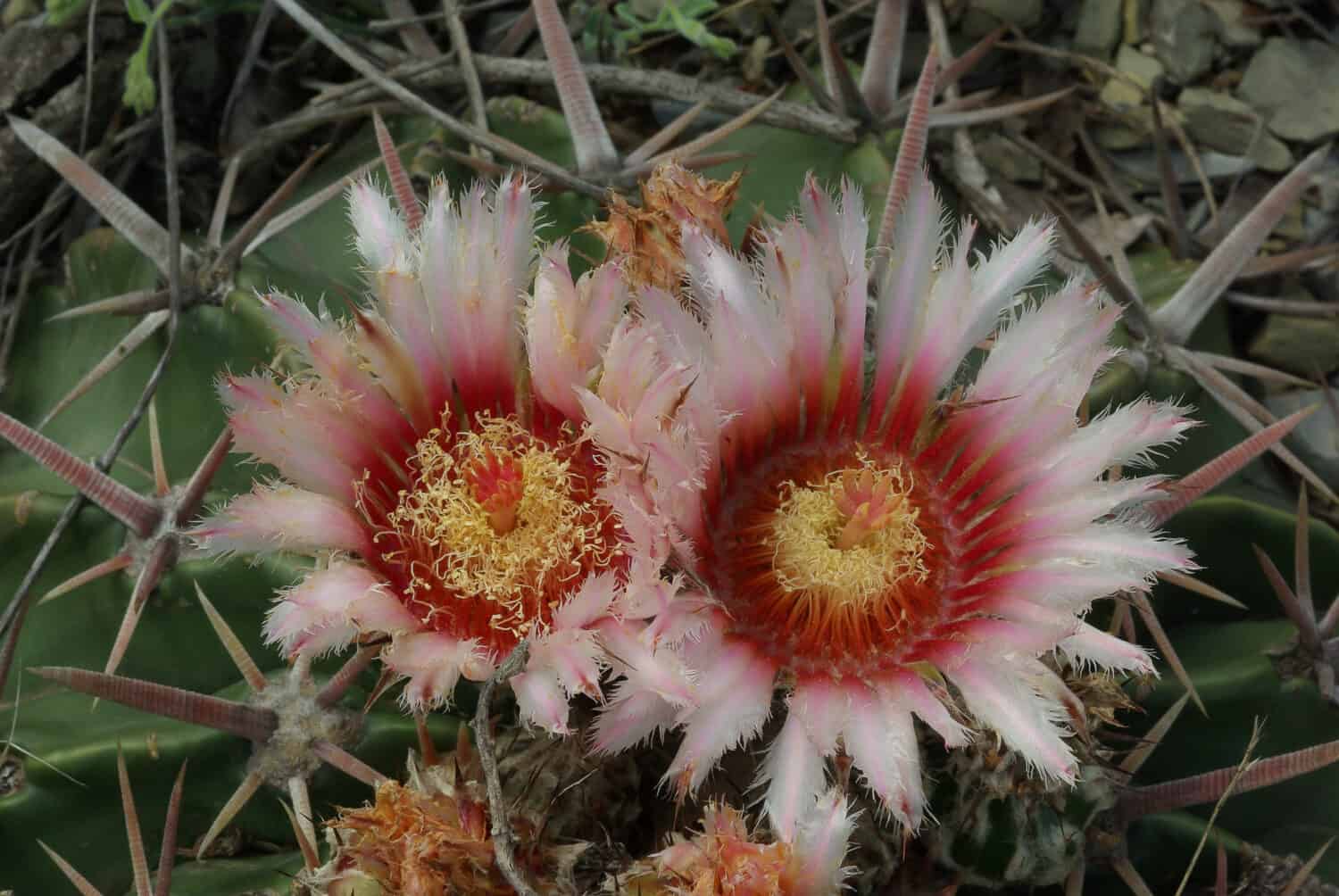
The horse clipper cactus is covered in claw-like spines.
©Vogelfotograf/Shutterstock.com
2. Living Rock Cactus (Ariocarpus fissuratus)
These grey-green cacti are native to Texas and northern Mexico. They have an extremely slow growth rate and are hard to spot in their natural habitat because they grow low to the ground and blend in with their surroundings. However, they are a little easier to spot in October through early November due to the beautiful pink flowers they bloom.
The leaves of the living rock cactus grow in layers with a rosette shape close to the ground. They grow in small populations in Texas and are considered a rare plant that collectors are on the hunt for. Living rock cacti have fleshy, thick leaves and grow around 7.5 inches in diameter. In addition, they lack the sharp spines that many other cacti species have.
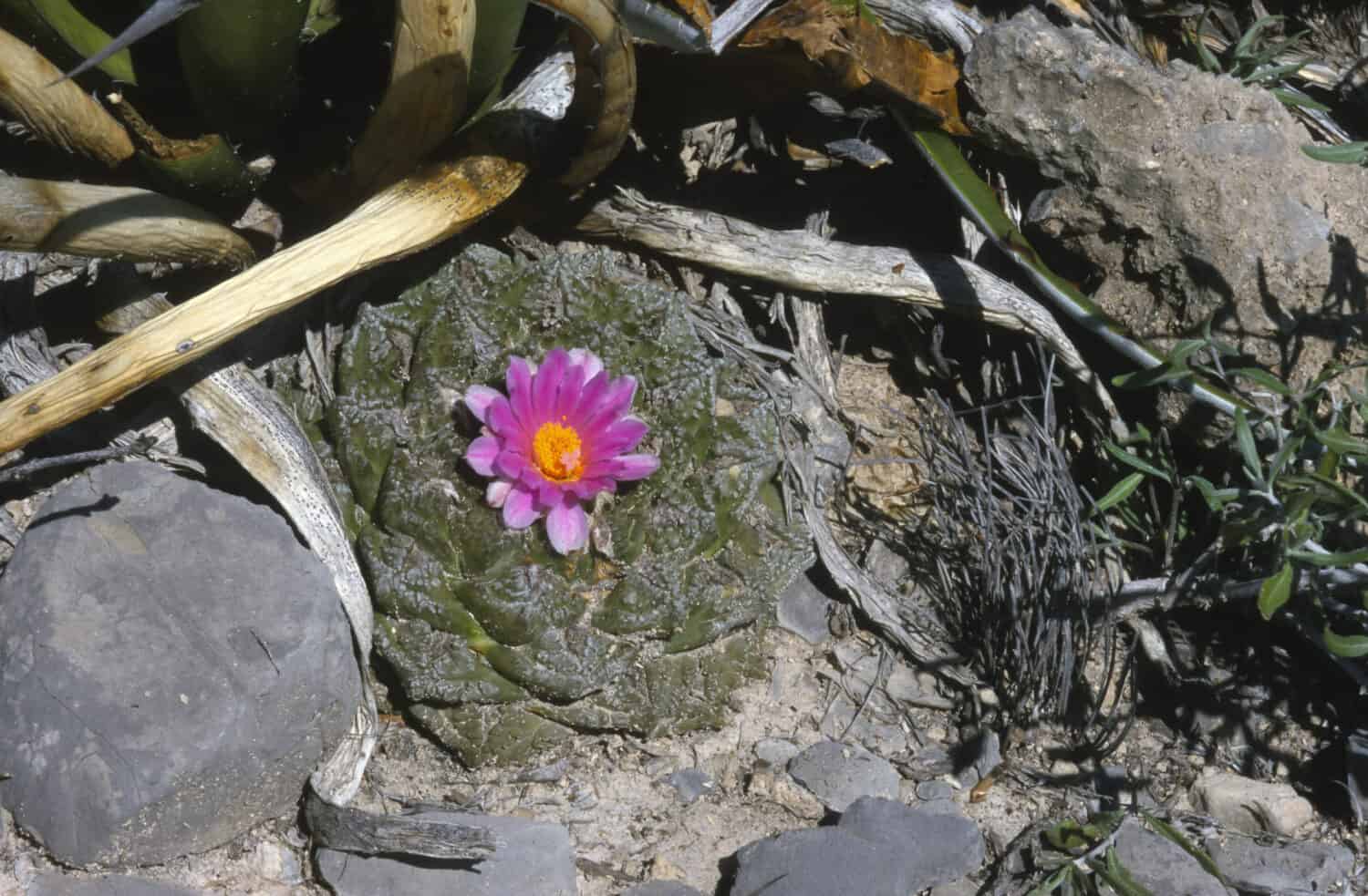
The living rock cactus is a low-growing cactus that is hard to spot in its natural environment.
©Vogelfotograf/Shutterstock.com
3. Scarlet Hedgehog Cactus (Echinocereus coccineus)
The scarlet hedgehog cactus is native to central and northern America and quite popular in west Texas. Also known as the scarlet beehive cactus, this cold-hardy cactus is often grown by gardeners in the north where there are cold winters.
This small cactus has a cylindrical shape and dark green stems with clusters of sharp spines. The color of the spines can vary from each plant, from grey, white, yellow, and brown, to dark red and black. The stems grow to 16 inches tall and 6 inches wide when mature. The scarlet hedgehog cactus is recognizable by its exquisite, funnel-shaped bright red or orange flowers that grow 3 inches long in the late spring and early summer.
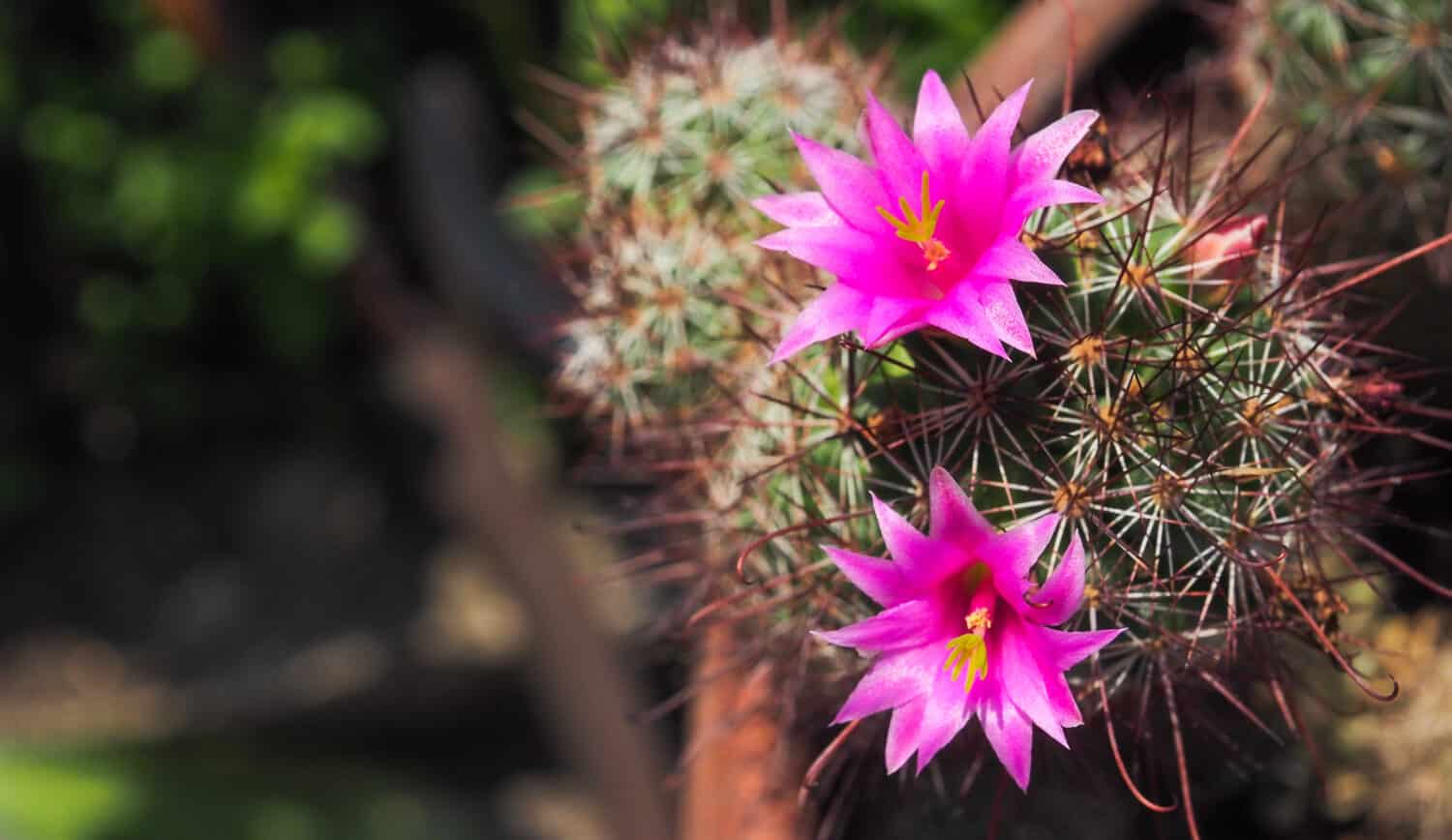
In the late spring, the scarlet hedgehog cactus grows striking red to orange flowers.
©Monontour/Shutterstock.com
4. Texas Rainbow Cactus (Echinocereus dasyacanthus)
The Texas rainbow cactus has many common names, including spiny hedgehog cactus, yellow pitaya, and Texas rainbow hedgehog. This thorny cactus is native to Texas, Arizona, and New Mexico in the United States and northern Mexico.
The Texas rainbow cactus is a low-growing cactus full of short spines that vary in color, such as pale yellow, tan, white, or pink. The areoles comprise 4-12 central spines and up to 24 radial spines that develop in various directions. Its stem is cylindrical and grows to around 10 inches long. The flowers bloom a bright yellow color that changes to pink or magenta as they age from March to May.

The Texas rainbow cactus gets its name from the spines that develop in a variety of colors.
©Cpifbg13/Shutterstock.com
5. Desert Christmas Cactus (Cylindropuntia leptocaulis)
The beautiful desert Christmas cactus is native to the Southwestern United States and throughout Mexico. Texas, Arizona, and New Mexico grow these prickly cacti in their hot deserts, grasslands, and woodlands.
The desert Christmas cacti have slender stems that grow 3 inches long and a quarter inch in diameter. They don’t have many spines covering their stems like a typical cactus, but they have one to 3 short spines per areole that are around 1.8 inches long. Easily spot the desert Christmas cactus by its pale green or yellow flowers and fleshy red berries that appear in December.
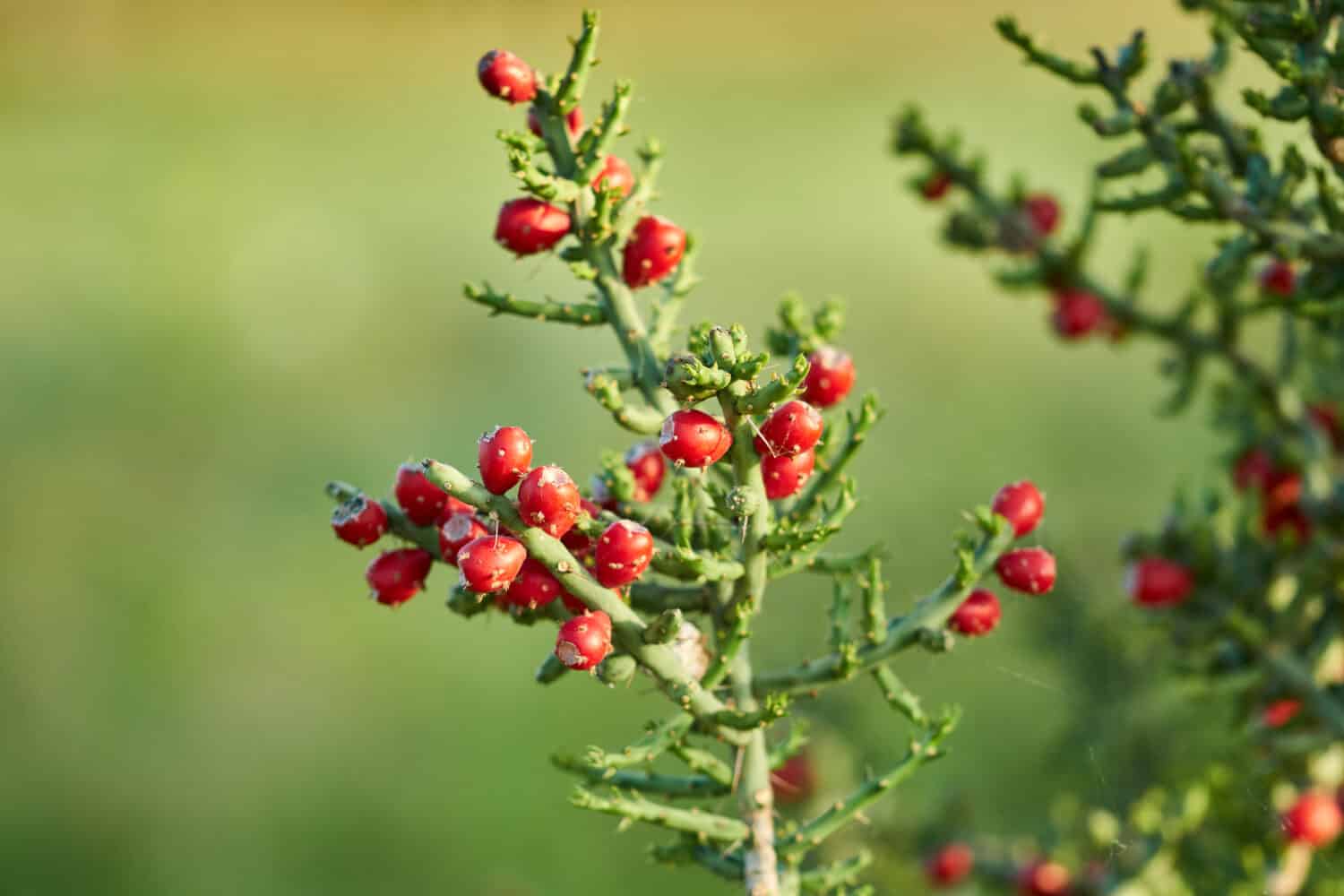
The bright red fruit of the desert Christmas cactus appears in December.
©The Jungle Explorer/Shutterstock.com
6. Blue Barrel Cactus (Echinocactus horizonthalonius)
The blue barrel cactus is native to western Texas and New Mexico, primarily in limestone substrate areas. You might have heard some of its other common names, such as devil’s head cactus and eagle claws. There are two main varieties of the Echinocactus horizonthalonius, which include:
- Echinocactus horizonthalonius var. horizonthalonius
- Echinocactus horizonthalonius var. nicholii (a rare variety)
The blue barrel cactus is a small, unbranched cactus that’s gray, green, and blue in color that grows to about 17 inches tall and 7 inches wide. They have a twist in the body and a flat top, giving them a unique shape. The areoles have 8-10 grey or brown spines 1.5 inches long. Expect stunning pink or magenta flowers blooming in June.

Blue barrel cacti grow exceptionally well in limestone substrate regions of Texas and New Mexico.
©Cpifbg13/Shutterstock.com
7. Nylon Hedgehog Cactus (Echinocereus viridiflorus)
The nylon hedgehog cactus is native to the central United States, south-central United States, and Northern Mexico. It has a hardiness zone of 6a to 11b, so it can survive in weather as cold as -5°F to as hot as 50°F.
It is a small, unbranching cactus with circular or cylindrical stems that can grow over 11 inches tall and 3 inches wide. Although the nylon hedgehog cactus is unbranched, some could squat clusters of numerous branches. The body of the cactus has areoles lined along it that have red, white, purple, yellow, or bicolored spines.

The spines of the nylon hedgehog cactus are white, yellow, red, or purple.
©Podolnaya Elena/Shutterstock.com
8. Green Strawberry Hedgehog Cactus (Echinocereus enneacanthus)
The green strawberry hedgehog cactus grows throughout New Mexico, Texas, and central and northeast Mexico. There are two main subspecies, including:
- Echinocereus enneacanthus brevispinus
- Echinocereus enneacanthus enneacanthus
The green strawberry hedgehog cactus develops clump-shaped, erect stems with spines containing a slight curve. The cylindrical stems grow 3 feet tall, with each areole having around 9 radial and 5 central spines. In early spring, the green strawberry hedgehog cactus will bloom flowers in various shades of red, pink, and purple.
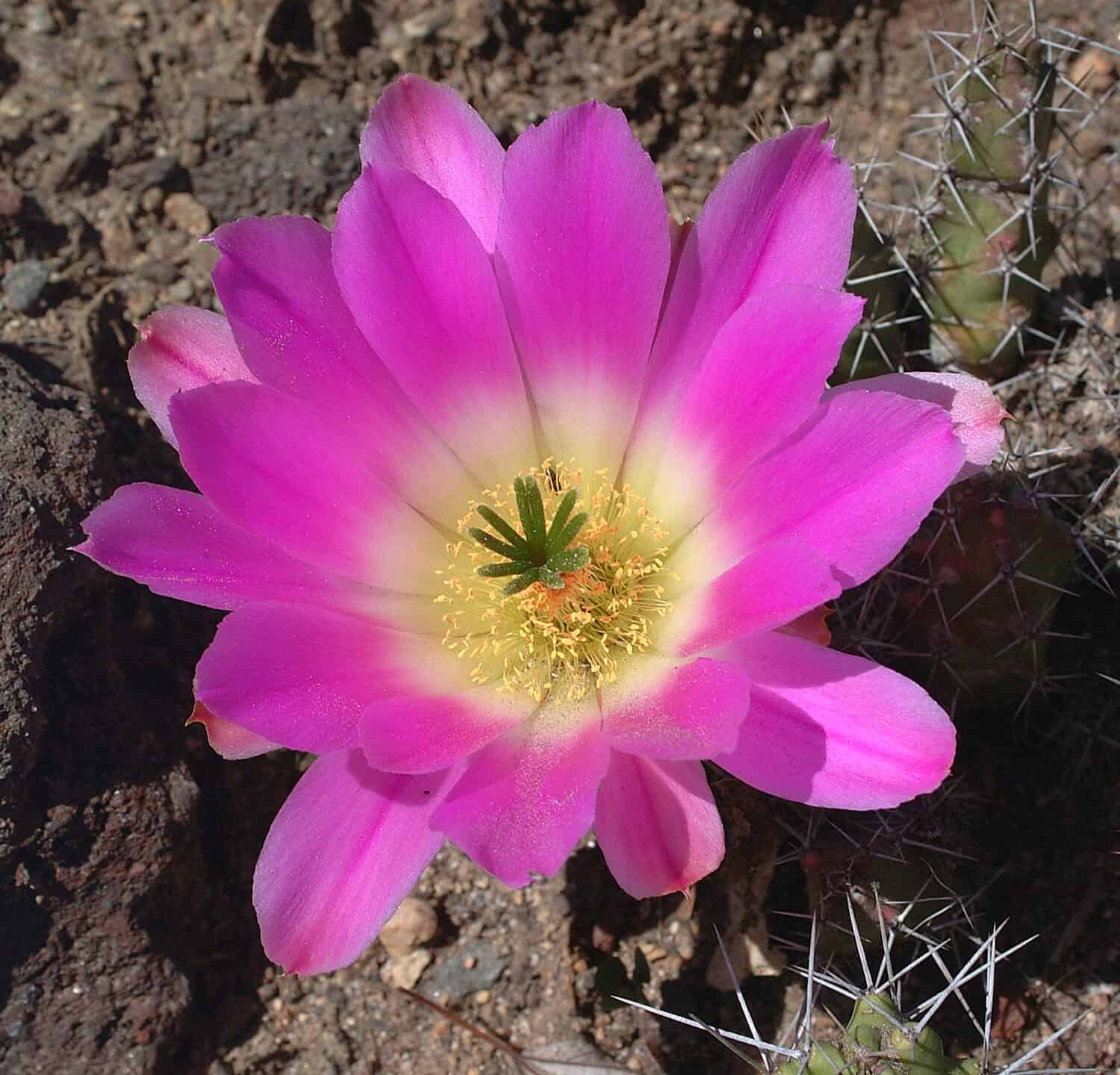
The green strawberry hedgehog cactus has bright pink flowers that bloom in early spring.
©simona flamigni/Shutterstock.com
9. Brown Flowered Cactus (Echinocereus chloranthus)
The brown flowered cactus is native to South New Mexica and West Texas, growing in graveled slopes with full sun. Its hardiness zone goes up to 11b, which means the brown flowered cactus can withstand temperatures as high as 50°F. However, because these cactus species are not cold-hardy, they should not be exposed to temperatures below 32°F.
This species can grow as high as 10 inches, with a width of 3 inches. The cactus has white, red, and dense brown colored spines that are almost an inch long. The brown flowered cactus grows flowers with reddish-brown or greenish-brown tepals, yellow anthers, and dark green stigma lobes. In addition, this cactus produces small, dull-red to green fruits with spines covering them.

The brown flowered cactus has fruits covered in many spines.
©Zdenka Kincel/Shutterstock.com
Final Thoughts
You might wonder, “Why would anyone want to grow cacti in Texas?” The answer is simple — it’s easy! Cacti are low maintenance and pretty. In addition, they are super hardy and can thrive in various climates. That’s right! You don’t have to live in an area with a desert climate to grow these plants. If you live in Texas or any other state with a warm climate, you can do this!
The photo featured at the top of this post is © iStock.com/Wirestock
Thank you for reading! Have some feedback for us? Contact the AZ Animals editorial team.







